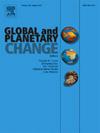The influence of grain size and mineralogical composition of terrestrial material inputs on organic carbon sequestration in the Bengal Fan since the last deglaciation
IF 4
1区 地球科学
Q1 GEOGRAPHY, PHYSICAL
引用次数: 0
Abstract
Exploring the intricate dynamics of organic carbon (OC) in marine sediments is essential for understanding global carbon cycling. This study examines how abrupt climate events, monsoonal variations, and mineral composition influence the delivery and burial of terrestrial organic matter (OM) in the western Bay of Bengal (BoB), focusing on the Bengal Fan (BF). Grain size and mineralogical composition have been critical in transporting and depositing terrigenous material, thereby affecting subsequent OC sequestration. Fine-grained sediments, notably those in the 2.5–10 μm range, are conducive to the widespread distribution and sequestration of terrestrial OM, facilitated by the force of monsoonal currents. In contrast, larger particles, particularly in the 30–46 μm range, tend to impede OC deposition. The mineralogy of the sediments also has a significant impact. Illite, for instance, is beneficial for OC transport and accumulation as it shields OM from microbial degradation and oxidative processes. Conversely, smectite is detrimental to OC preservation. Its high permeability, poor adsorptive capabilities, and association with OM-degrading environments can result in the loss of OC during transport and sedimentation, particularly in more distal ocean settings. The interaction between lithogenic materials and OM from both marine and terrestrial sources highlights the complexity of sedimentation processes in the BF. This study underscores that mineral composition and grain size characteristics played a crucial role in controlling OC sequestration. Before 9.5 ka, terrestrial OM was a substantial contributor to OC deposition in association with marine OM, driven by more vigorous monsoons and active river channels during lower sea levels. However, after 9.5 ka, the rapid rise in sea level altered river channels and delta dynamics, leading to reduced sedimentation rates and a decreased OM accumulation in the western BoB. During the Holocene Climate Optimum (HCO: 9.5–5.5 ka), the increased input of freshwater from intense summer monsoons led to the stratification of the water column, which reduced upwelling and primary productivity, which, in turn, led to less OC accumulation and preservation. The study highlights the importance of the summer monsoon in transporting terrestrial and marine OM to the deep ocean, emphasizing its crucial role in regulating the global carbon budget.
末次冰期以来陆源物质输入粒度和矿物组成对孟加拉扇有机碳封存的影响
探索海洋沉积物中有机碳(OC)的复杂动态对于理解全球碳循环至关重要。本研究探讨了气候突变事件、季风变化和矿物组成如何影响孟加拉湾西部(BoB)陆相有机质(OM)的输送和埋藏,重点研究了孟加拉扇(BF)。颗粒大小和矿物组成对运输和沉积陆源物质至关重要,从而影响随后的碳封存。细粒沉积物,特别是2.5 ~ 10 μm的沉积物,在季风洋流的作用下,有利于陆地有机质的广泛分布和封存。相反,较大的颗粒,特别是在30-46 μm范围内,倾向于阻碍OC的沉积。沉积物的矿物学也有显著的影响。例如,伊利石有利于OC的运输和积累,因为它可以保护OM免受微生物降解和氧化过程的影响。相反,蒙脱石不利于OC的保存。它的高渗透性、较差的吸附能力,以及与om降解环境的关联,可能导致OC在运输和沉积过程中损失,特别是在更远的海洋环境中。造岩物质与海相和陆相有机质的相互作用凸显了高炉沉积过程的复杂性。该研究强调矿物组成和粒度特征在碳封存中起着至关重要的作用。在9.5 ka以前,受较强的季风和较低海平面时期活跃的河道的驱动,陆地OM是与海洋OM相关的OC沉积的重要贡献者。然而,在9.5 ka之后,海平面的快速上升改变了河道和三角洲动力学,导致西段沉积速率降低和OM积累减少。全新世气候优化时期(HCO: 9.5 ~ 5.5 ka),强烈夏季季风带来的淡水输入增加,导致水体分层,导致上升流和初级生产力减少,从而导致OC积累和保存减少。该研究强调了夏季季风在将陆地和海洋有机质输送到深海中的重要性,强调了它在调节全球碳收支方面的关键作用。
本文章由计算机程序翻译,如有差异,请以英文原文为准。
求助全文
约1分钟内获得全文
求助全文
来源期刊

Global and Planetary Change
地学天文-地球科学综合
CiteScore
7.40
自引率
10.30%
发文量
226
审稿时长
63 days
期刊介绍:
The objective of the journal Global and Planetary Change is to provide a multi-disciplinary overview of the processes taking place in the Earth System and involved in planetary change over time. The journal focuses on records of the past and current state of the earth system, and future scenarios , and their link to global environmental change. Regional or process-oriented studies are welcome if they discuss global implications. Topics include, but are not limited to, changes in the dynamics and composition of the atmosphere, oceans and cryosphere, as well as climate change, sea level variation, observations/modelling of Earth processes from deep to (near-)surface and their coupling, global ecology, biogeography and the resilience/thresholds in ecosystems.
Key criteria for the consideration of manuscripts are (a) the relevance for the global scientific community and/or (b) the wider implications for global scale problems, preferably combined with (c) having a significance beyond a single discipline. A clear focus on key processes associated with planetary scale change is strongly encouraged.
Manuscripts can be submitted as either research contributions or as a review article. Every effort should be made towards the presentation of research outcomes in an understandable way for a broad readership.
 求助内容:
求助内容: 应助结果提醒方式:
应助结果提醒方式:


